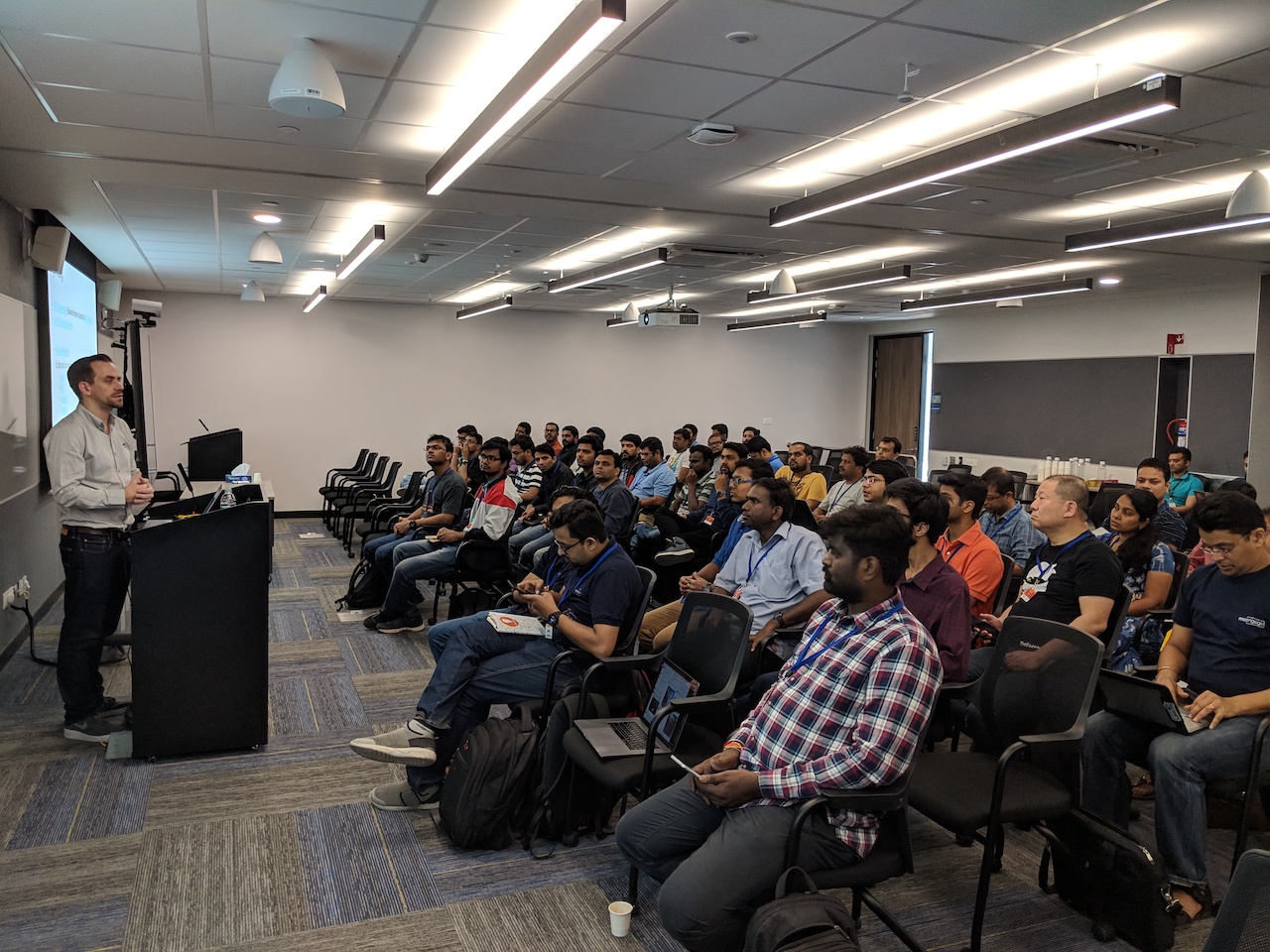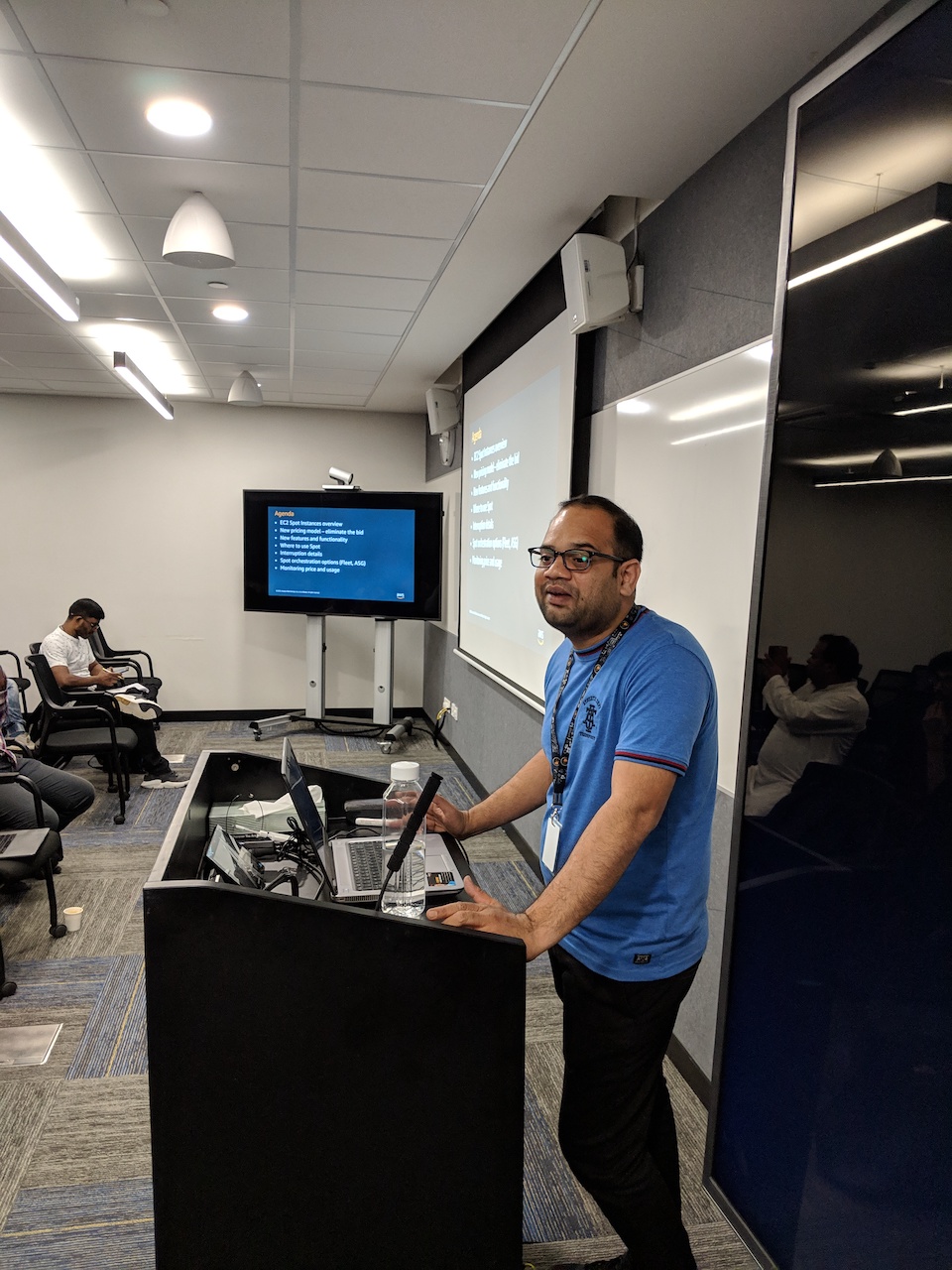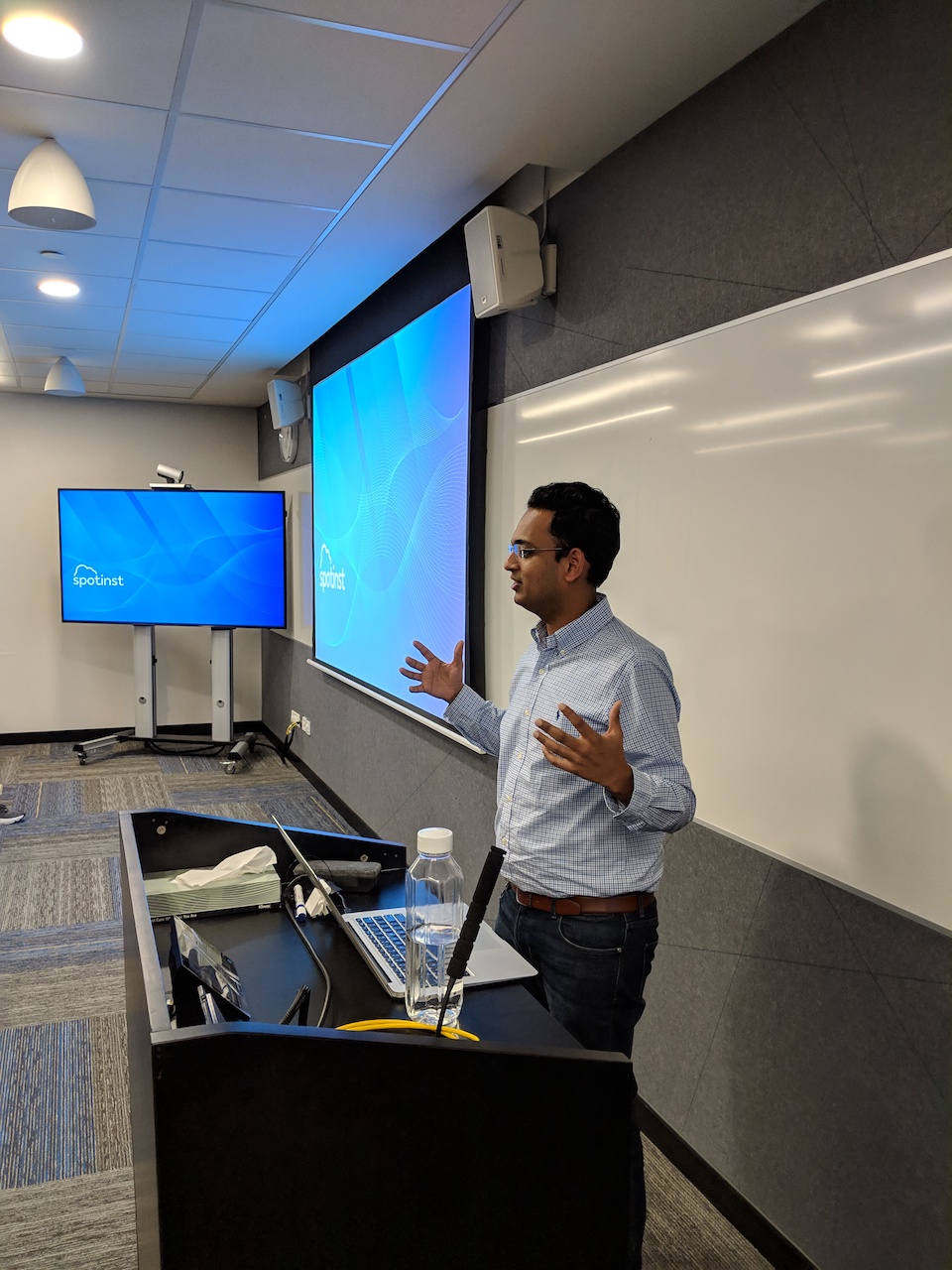Meetup report: November 2018 Meetup on Cost Optimization
Summary of November 2018 Meetup
The November 2018 meetup was held at the newly opened Amazon Internet Services Private Ltd office.
The session started with a Welcome note by Sathyajith, co-organizer, AWS User Group Bengaluru. It was followed by a deep dive session on Cloud Financial Management Fundamentals by Spencer Marley, Commercial Architect, Amazon Web Services. The second session was by Chakravarthy(Chakra) Nagarajan, Solutions Architect, EC2 Spot, Amazon Internet Services Private Ltd, who instilled the thoughts in us that Spot Instances are not just pricing mode but best architecture practise with interesting demo. Post this, Saket Agarwal, Head of Business Development for Spotinst gave a brief demo about what SpotInst is and how SpotInst is helping customer with their managed services using spot instances.



Finally, we had Neeraj from Moonfrog, and Gaurav from Boomerang Commerce explain how they are using Spot instances.
Here are some key takeaways from the sessions:
- Culture and mechanisms are as important as technical and financial constructs on cost savings.
- Perceive Spot Instances as a best architecture practice but not just a pricing model.
Overview of Spot Instances
Amazon EC2 Spot Instances offer spare compute capacity available in the AWS cloud at large discounts compared to On-Demand instances.
Spot Instances can be used for:
- Big data workloads
- Containerized workloads
- High performance computing
- CI/CD pipelines
- Stateless web servers
- Testing and development workloads
Spot Instances Features:
- Cost saving up to 90% (Low cost)
- With options of termination (default option), start/stop and hibernate (New feature), one can run workloads without interruptions
Some features of Spot explained
- AWS Instance Scheduler: It enables customers to configure custom start and stop schedules for EC2 and RDS instances.
- Reserved instances convertible class: It enables to exchange one or more Convertible Reserved Instances for another Convertible Reserved Instance with new attributes (instance family, instance type, platform, scope and tenancy).
- AWS Budget: it gives the ability to set custom budgets that alert, when your costs or usage exceed your budgeted amount. One can also use AWS Budgets to set RI utilization or coverage targets and receive alerts when utilization drops below the threshold you define. Reserved instances alerts support Amazon EC2, Amazon RDS, Amazon Redshift, and Amazon ElastiCache reservations.
- Spot bid adviser: It help to determine an Amazon EC2 Spot instance bid price that suits our needs.
- Spot instance pool and Step scaling metrics: A Spot Instance pool is a set of unused EC2 instances with the same instance type, operating system, Availability Zone, and network platform.
- Hibernating a Spot instance: When a Spot Instance is hibernated by the Spot service, the EBS volumes are preserved and instance memory (RAM) is preserved on the root volume. The private IP addresses of the instance are also preserved. Instance storage volumes and public IP addresses, other than Elastic IP addresses, are not preserved.
Summary of the talks
Cloud Financial Management Fundamentals by Spencer Marley
Pillars of Cloud Financial Management Fundamentals
- Right sizing
- Select the cheapest instance, right CPU / RAM & so on
- Elasticity
- 70% savings can be achieved by using Elasticity
- Pricing Models
- OnDemand, Spot & Reserved
- You should be able to convert the instance type from RI to OnDemand & vice versa as many times as possible without any downtime.
- Storage Classes
- Culture & Mechanisms
- Culture & Mechanisms are as important as technical and financial constructs on cost savings.
- Design for cost
- Spot instances can be used at various places like prod & non-prod workloads, CI / CD etc.
3 key take aways from Spencer Marley are to use Cost Explorer to analyze and have the moto as Reserve, Review, Rinse & Repeat
AWS EC2 Spot instances by Chakravarthy(Chakra) Nagarajan
- AWS EC2 Consumption models:
- On Demand (pay for capacity by second, no commitments)
- Reserved (significant discounts for commitments)
- Spot ( spare EC2 capacity for up to 90% discounts, for fault tolerant, or time-insensitive workloads)
- Simple rules of spot instance:
- Price changes infrequently based on supply and demand of the spare capacity
- User just need to request a capacity and pay the current rate. When the demand increases, capacity will be revoked with a 2 minute warning.
- Handling interruptions:
- 95% were not interrupted by AWS
- Check for 2 minute termination notice and automate by
- Check pointing
- Draining from ELB
- Using stop-start and hibernate to restart faster
- Interruption notice via CloudWatch events or manually polling instance metadata
- Basically there are two types of fleet: Spot fleet & Amazon EC2 fleet
- Spot fleet:
- Onetime request or maintain collection of EC2 instances
- Allocation strategy: Lowest price or diversified across n number of pools
- Amazon EC2 fleet:
- Simplifies provisioning of EC2 capacity across different instance types, AZs and purchase models with a single API
- Spot blocks: Define duration of workload (1-6 hours) but not highly discounted as you are blocking / reserving for specified duration.
- Spot fleet:
SpotInst by Saket Agarwal
Spotinst is a proactive application scaling service, designed to optimize compute in the cloud. SpotInst enables following features to improve experience of using Spot:
- ELB Integration and Auto-scaling
- Connection Draining
- Enterprise-grade SLA
- Average of 35 days of up time
- Pricing model: 14-day free trial. SpotInst charges 20% of savings
SpotInst challenges saying "If you launch via AWS, you will have 2 minutes interruption whereas 15 minutes when launched via SpotInst".
Slides & resources
Links to the slides:
- Cost Optimization
- EC2 Spot Instances
- GitHub Repo for collection of tools and code examples to demonstrate best practices in using Amazon EC2 Spot Instances.
AWSUGBLR organizers would like to thank
- The speakers: Spencer, Chandra, Saket, Gaurav, Neeraj for explaining the various concepts and use cases
- Attendees for taking time out of their Saturday and joining us for the meet
- Amazon Internet Services Private Limited for hosting the meetup and providing stickers, tea/coffee and lunch
- Piyush Jalan for contributing to the meetup report and Bhuvaneswari for supplemental inputs
Stay tuned for upcoming meetups! For any feedback, comments, requests or contributions, please write to us on mailto:info@awsugblr.in